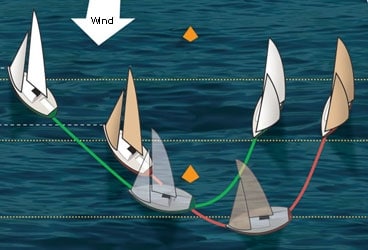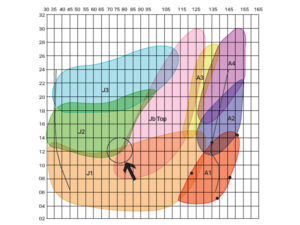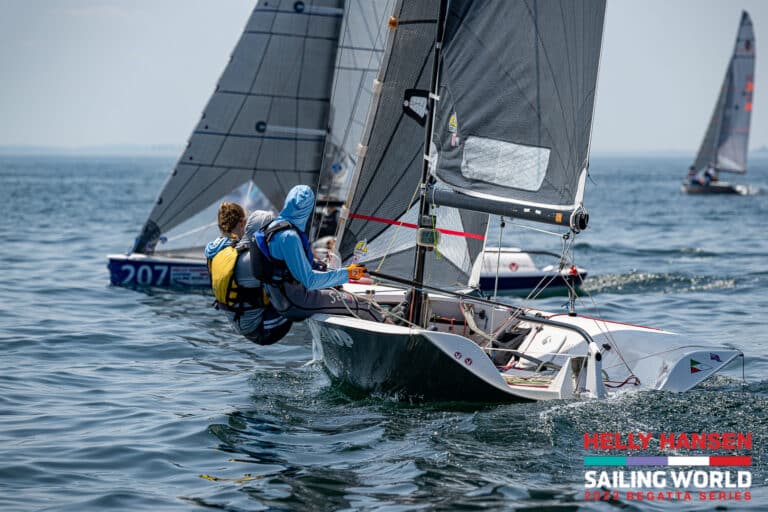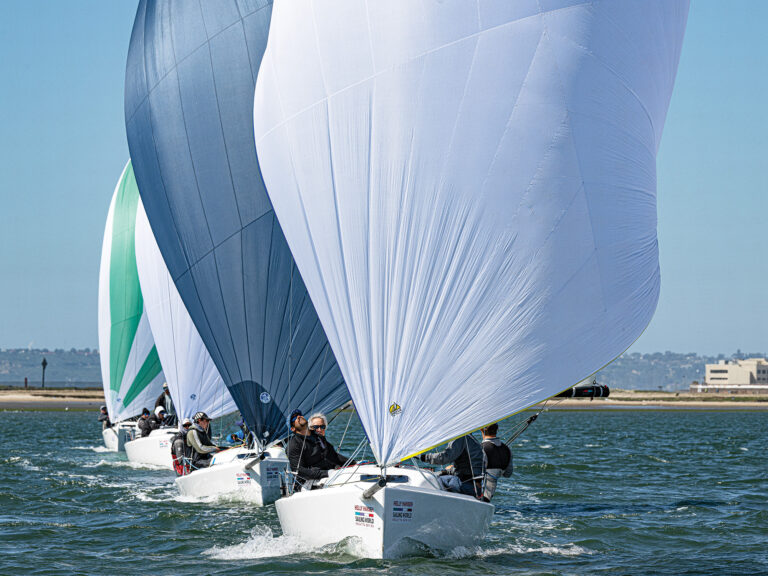
FTEHorton368
The classic leeward-mark rounding is to come in wide and round tight to the mark as you head upwind. It’s a technique endorsed by numerous experts and authoritative racing texts, but could there possibly be a better way? I recently posed the question to Andy Horton, who sailed with Luna Rossa in the 32nd America’s Cup in Valencia. As it turns out he’s been doing a lot of research on the topic and has come to some surprising conclusions.
-Dave Powlison
I was turned on to this subject two years ago when I arrived in Valencia and could watch the racing on Live Sailing (online 3D-race animation, www.americascupanywhere.com). The whole game, especially in the America’s Cup, is meters-one meter here, one meter there. I noticed that Alinghi and Oracle would go to opposite gates and round a certain way, and when they went into the same gate mark together, they each rounded a different way.
I analyzed screen shots of the Live Sailing playback from numerous roundings and it became clear that, in certain situations, there was a right and wrong way to round the mark. On Live Sailing, you can literally see the changes in distance, and it wasn’t because of spinnaker takedowns, one gate being favored, or anything like that. Many times the two boats would be bow-to-stern entering the two-lengths zone and then, with two different styles of mark rounding, one boat would exit the mark with a 10- to 20-meter gain (an America’s Cup Class boat is approximately 25 meters long).
The boat that was losing out was rounding in the traditional way-coming in wide and then taking the mark close as it headed up to a close-hauled course. The other boat, the one that gained, rounded so that the mark was at the apex of its turn. We called this an apex turn. You’re always going to make the same turn, regardless of how you round the mark. The apex turn is your optimum radial turn-you’re not skidding out, the sails are coming in perfectly, and the boat doesn’t slow down any more than necessary when completing the turn. Take a look at Diagram 1, which shows the mark position relative to these two rounding methods. The boat with the green track is doing an apex turn while the boat with the red track is doing the tried-and-true, wide-then-tight leeward mark rounding.
The dotted horizontal lines represent the ladder rungs of the course. The traditional route costs that red boat a significant amount of distance toward the next mark. While making his tactical turn, he’s sailing downwind a half boatlength extra and then upwind a half boatlength extra. On an America’s Cup boat, we found the difference between one and the other could be as much as 20 meters.
This technique especially pays off if you and your competition are going around separate gate marks. For example, you and your chief rival take opposite sides of a perfectly square leeward gate, neither one closer to the wind than the other. One boat rounds traditionally-again the left-hand boat with the red track-while the other uses an apex turn. For this exercise we’ll assume both make perfect turns of the same radius. Diagram 2 above shows how much the boat doing the apex turn gains. It’s as if the right-hand boat starts the leg with a one-boatlength advantage.
A boat making a traditional tactical rounding will be a little further to windward of a boat that makes an apex turn around the same mark. However, if you’re giving up a few feet to windward, you’re gaining much more forward by sailing a shorter overall distance. If we look at the diagram on the previous page, the boat behind is not in a better position. The only thing it gets is a little clean air.
This concept becomes pretty clear when you think of it in terms of a starting line. If two boats start bow-to-bow on a square line (see the right hand two boats in Diagram 3) they would be even. One is to the right of the other and has a starboard-tack advantage, but everything else is even. Now, when you draw in a boat that has gained the exact amount shown in the first diagram-one-length forward-and lost one quarter of a length to leeward, that boat is clearly ahead and in a much more powerful leebow position.
However, there are times when a traditional turn is still better than an apex turn, despite the extra distance sailed.
Generally, the traditional wide-then-tight turn is best when you are behind. This is primarily because it’s likely to get you clean air and a better lane exiting the leeward gate. You will sail extra distance, and other boats will gain on you, but you will be able to hang in your lane longer. If you are planning on tacking away right at the mark, and there is no one behind you to potentially catch you on starboard, or for tacking too close, then an apex turn would be better. You will sail less distance and because you are tacking right away you need not worry about sailing in dirty air.
Another time when the traditional turn works best is when you’re just ahead of another boat, leading the race, and one gate is strongly favored, so everyone is rounding that gate. In this situation, do a deep tactical turn and come in close to the mark, in the traditional way. This puts the boat behind you into your disturbed air and leaves him with the difficult choice of hanging in your dirty air or tacking into the fleet coming downwind.
If you are in a similar situation, except that a pack of boats are going around the opposite gate mark, you will have to be careful. A traditional turn will hurt the boat directly behind you, but you will lose distance to the other pack. A flatter apex rounding in this situation will allow the boat behind to live for a few extra seconds, but you will gain an extra boatlength on the pack going the other way.
There are many times when the “wide-then-tight” style of rounding is definitely the best option, but there are also some times when you could make an easy gain on the fleet with an apex turn. Coming into a leeward mark I always plan on doing a traditional turn and then if I see an opportunity to make a quick gain with an apex turn I call to drop a the kite a little earlier and “cut the corner.”









